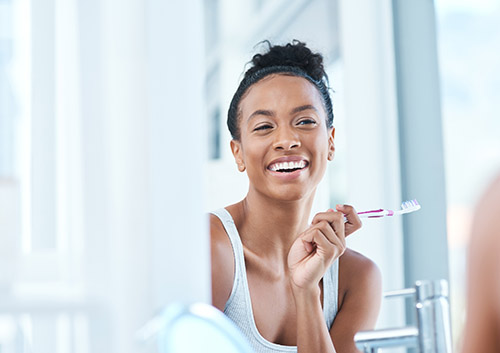Three Classic New Year’s Resolutions for Your Dental Health —and Three Which Might Surprise You!
December 31st, 2025

Whether you’re using the latest note-taking app or old-school pen and paper, it’s a good time to start jotting down your resolutions for a healthier, happier New Year. To help the process along, we have some suggestions for traditional tooth-friendly resolutions—and also some ideas which might surprise you!
The Classics
- Brush and Floss Regularly
If you’re sticking to the “two minutes twice a day” brushing schedule as well as flossing once a day, great work! Often, though, that two-minute window starts to shrink as our brushing routine becomes *too* routine. Try timing yourself while you brush normally. If you’re falling quite a bit short of two minutes, taking just a bit more time will be lots more effective in removing plaque from your teeth.
And since gum disease is a leading cause of tooth loss in adults, commit to flossing once a day to remove irritating plaque and bacteria from between teeth and around the gumline.
- Use Fluoride Toothpaste
Fluoride toothpaste doesn’t just help prevent cavities by cleaning away plaque and food particles. It also helps make our enamel stronger.
Acids created by plaque bacteria and acids in our diet dissolve minerals from tooth enamel, making it softer and more vulnerable to cavities. Fluoride bonds with the minerals in enamel to create an even stronger protective enamel coating. Check with Drs. Angela Paros, Amer Atassi, Eric Young, Alexander Katsnelson or the American Dental Association’s website for the best toothpaste choices for healthy, strong enamel.
- See Your Dentist Regularly
Dentists typically recommend a full dental exam and cleaning twice each year. Your dental team at High Point Dental Group will take X-rays as needed, examine your teeth, gums, and general oral health, and screen for oral cancer. A professional cleaning will remove any built-up plaque and tartar, which is especially important for gum health.
Being proactive with your dental care means you’ll be sharing your healthy smile all year long—as well as discovering any potential problems before they can develop into major problems!
The Surprises
- Chew (Sugarless) Gum
When you’re not producing enough saliva, you feel the effects of dry mouth, including sore throat, difficulty swallowing, and bad breath. Another side effect? Poorer dental health.
Saliva helps neutralize the acidic foods we eat, washes away bacteria and food particles, and contains minerals like calcium and phosphorus which remineralize tooth enamel. Chewing sugarless gum encourages saliva production. If you suffer from dry mouth, check with your dentist to see if chewing sugar-free gum can help.
- Don’t Brush Right After Eating
Brushing after a meal is great to remove food particles like sugars and carbs which stick to our teeth—and which the bacteria in plaque thrive on. But if you’ve been eating or drinking acidic foods, it’s best to wait about an hour before brushing.
Acids in foods, like acids created by bacteria, weaken tooth enamel. Brushing right away can be abrasive and damage enamel, but if you wait for an hour, the minerals in saliva have a chance to remineralize and restore your enamel strength.
- Toss Your Toothbrush
Not that we mean give up brushing altogether! But your toothbrush bristles start to fray and fan out after several months, meaning that you won’t be getting the full cleaning effects of your great brushing technique. Put a note on your calendar to replace your brush every three to four months for the best in plaque removal.
If you’re already following all these suggestions for protecting your dental health, resolve to keep up the good work! If not, give these easy-to-follow recommendations a try. Protecting your dental health is essential to gift yourself a new year filled with happy, healthy smiles in Romeoville, IL.
Why Do We Say That Implants Function Like Natural Teeth?
December 24th, 2025

One of the most appealing reasons to choose dental implants over options such as bridges, partial dentures, and complete dentures is the fact that they function like natural teeth.
Unlike bridges and dentures, which sit above the gumline, implants are embedded in the jawbone, designed to look like and to work like a natural tooth:
- A cylinder or screw, usually made of bio-compatible titanium, is surgically implanted into the jawbone. After several months, the implant fuses with the bone, a process called “osseointegration.”
- An abutment is secured inside the implanted piece. This abutment extends above the gumline and serves to connect the implant to a crown.
- A dental implant crown customized to match surrounding teeth in shape and appearance is securely attached to the abutment.
The result is a tooth that looks and functions just like a natural tooth, with a secure implant acting as a root below the gumline attached to a realistic-looking crown above it. What does this unique design mean for you?
- Implants Are Secure
Because implants are rooted in your jaw, there is no need to worry about loose dental work or difficulties with pronunciation or eating. Dentures stay in place using a mild adhesive or suction, which attaches them to the gum ridge. Bridges are anchored to teeth on either side of the missing tooth or teeth. Implants, on the other hand, are anchored in the jawbone. The post of the implant fuses with the bone in your jaw, functioning just like the root of a natural tooth.
Implants often are used to replace a single tooth, but if you have lost several teeth, you also have options. Implants are an effective way to hold bridges and dentures in place securely. Several posts are implanted in strategic locations. Once the posts have fused with the jawbone, the bridge or denture is secured to the posts. These appliances can be fixed in place or removable for easy cleaning.
- Implants Maintain Bone Health
When you choose an implant, you are choosing an option which protects your natural bone health and facial appearance. When a tooth is lost, the jawbone beneath it can shrink over time. This process is called “resorption.” Bone loss can alter facial appearance, especially around the lips, cheeks, and profile.
Why do we lose bone? The bone in our jaws stays healthy because the stimulation of chewing and biting encourages new bone cell production around the root. Without that stimulation, the jawbone doesn’t replace old bone cells as effectively, and gradually shrinks, even with a bridge or denture. Implants, on the other hand, provide the same stimulation to the bone that natural teeth and roots do, and bone cells regenerate just like they do with natural teeth.
- Implants Don’t Affect Surrounding Teeth
When you choose a fixed bridge to replace a missing tooth or teeth, the neighboring teeth must be shaped to hold the bridge attachment. This is done by removing some healthy tooth structure from each neighboring tooth. Retainer crowns are then placed on these teeth to hold the pontic, or replacement teeth, in position.
Implants don’t require crowns or other anchoring mechanisms on surrounding teeth. What’s more, implants benefit the teeth around them by helping to preserve the shape and strength of the jawbone holding them in place.
- Implants Last
Dentures and bridges can be a more cost-effective option initially, but they will need to be replaced every 5-10 years. Implants are the longest lasting tooth replacement. Many implants will last a lifetime.
How to make sure your implant is successful? Look after your dental hygiene to prevent gum disease, a leading cause of tooth loss in adults. If you grind your teeth, talk to Drs. Angela Paros, Amer Atassi, Eric Young, Alexander Katsnelson about a nightguard. Wear a mouthguard when you play sports. Avoid biting into hard foods like ice and hard candies. Don’t smoke. In other words, protect your implants just like you protect your organic teeth.
- Implants Look Natural
For many of us, the realistic appearance of dental implants is the deciding factor.
Dental implants are designed to look just like your natural teeth. The crown which sits atop the implant post is carefully fabricated to match the size, shape, and color of your surrounding teeth. You can eat, speak, and smile confidently once again.
Periodontists are experts in implant dentistry, because they have years of additional education and training after dental school specializing in treating the bones and gums which support our teeth. If you’re considering tooth replacement, talk to the team at High Point Dental Group in Romeoville, IL about your options. You might discover that a dental implant is the natural choice for you!
Can Toothpaste Repair Tooth Decay?
December 17th, 2025

It seems like the ads are everywhere these days—repair your enamel and reverse tooth decay with a tube of toothpaste! Are these claims too good to be true? Let’s dive into the science of tooth decay—how decay develops and how (and if!) it can be reversed.
Teeth can stand up to the powerful pressures of biting and chewing because over 95% of our enamel is made up of minerals. Calcium and phosphate ions in our teeth bond to form a crystal structure called hydroxyapatite. Because of the strength of this crystalline design, tooth enamel is the hardest substance in our bodies, even stronger than our bones.
But bones, like most other parts of our bodies, are living tissue, which means that they can create new cells to replace old or damaged cells. Tooth enamel can’t regenerate new cells to repair itself. This means that when a cavity has made a hole in the tooth, the enamel can’t grow back. And, while enamel structure is very strong, it’s also vulnerable to damage—specifically, damage from acids.
Our teeth are exposed to acids throughout the day, whether they are acids created by plaque bacteria or the acidic foods and drinks we consume. Acids dissolve mineral bonds, stripping calcium and phosphate minerals from the enamel and leaving weak spots in the tooth surface. This process is called demineralization. Demineralization is the first stage of tooth decay.
The good news? Our bodies are designed with a built-in defense mechanism to prevent demineralization from causing lasting damage. All through the day, saliva helps wash away acids in the mouth and bathes our teeth with new calcium and phosphate ions. These ions bond with the calcium and phosphate in our enamel, restoring enamel strength. This protective repair process is called remineralization.
Now for the bad news. In the tug of war between demineralization and remineralization, saliva can only do so much. If your diet is heavy with acids, if you don’t brush away acid-producing plaque bacteria regularly, if you eat a lot of the sugars and starches which feed plaque bacteria, the remineralizing effects of saliva can’t keep up with the demineralizing effects of acids.
The first visible sign of demineralization is often a white spot on the tooth where minerals have been stripped from enamel. Studies have shown that enamel-strengthening toothpaste can be effective in this very first stage of tooth decay. Toothpastes which advertise enamel repair generally contain one or more of these ingredients:
- Calcium Phosphate
- Hydroxyapatite
- Fluoride
Toothpastes with calcium phosphate or hydroxyapatite contain calcium and phosphate minerals, the building blocks of tooth enamel. Studies have suggested that these minerals can replace the calcium and phosphate ions stripped from enamel. These toothpastes may or may not contain fluoride, which is something you should discuss with your dentist before deciding on a specific toothpaste.
Fluoride toothpastes remineralize enamel—and more! Fluoride ions are attracted to the tooth’s surface, and, when fluoride ions join with the calcium and phosphate ions there, they form fluorapatite. Fluorapatite crystals are larger, stronger, and more resistant to acids than hydroxyapatite crystals. And, once bonded with tooth enamel, fluoride attracts the calcium and phosphate ions in saliva to remineralize the teeth more quickly.
Why consider enamel-repair toothpaste?
Once enamel is gone, it’s gone for good. If excess demineralization isn’t treated, a weak spot on the tooth surface will continue to erode, growing bigger and deeper until it becomes a hole in the enamel. This is a cavity, and your dentist will need to treat and repair your tooth to prevent the cavity from growing and potentially exposing the tooth’s pulp to bacteria and infection.
Talk to Drs. Angela Paros, Amer Atassi, Eric Young, Alexander Katsnelson at our Romeoville, IL office about which toothpastes can help restore a healthy balance between the ongoing cycles of demineralization and remineralization. While tooth-repair toothpaste can’t fix cavities, these products can often strengthen demineralized enamel and reverse this earliest stage of tooth decay.
Creating a Dental Home
December 10th, 2025

As a parent, you know how important a happy, relaxed atmosphere is when it comes to making your child feel at home. We would like to make our Romeoville, IL practice your dental home, where you and your family enjoy the best of dental care in a warm and welcoming environment.
What makes a dental home?
- It’s Welcoming
From your child’s first visit, we strive to make you both feel at ease. Our office is designed to be a happy, entertaining, and relaxing place, and our staff is trained in making little ones feel calm and secure. We want to have a lasting relationship, and we want you and your child to feel welcomed back whenever you return.
- It’s Familiar
We recommend visiting our office for the first time by the time of your child’s first tooth or first birthday. Our early visits are designed to make your child familiar with what a dentist does and how a dentist helps keep children healthy. Regular preventative care will keep those little teeth in great shape, and, if your child has a cavity that needs filling or requires any other dental procedure, we will have a history together and a familiar place to experience an unfamiliar treatment.
- It’s Comfortable
We use state-of-the-art dentistry to make sure your child has the best and most comfortable treatment as a patient, and we also consider the psychological aspect of each visit for your particular child. We are experienced in dealing with children who might feel anxious and working with them to overcome their worries. Part of our job is to make each visit a happy one, so your child is always comfortable visiting us.
- It’s Ongoing
We want to establish a relationship that will last through the years. Continuity of care means that we are able to follow your child’s dental development during those active growing years and the transition from primary to permanent teeth. We provide not only dental health education, treatment, and preventive care, but can track any changes or potential problems before they become major issues. In case of a dental emergency, we will be familiar with your child personally, and with a dental history at hand.
Give Drs. Angela Paros, Amer Atassi, Eric Young, Alexander Katsnelson a call to talk about your child and how we can make the dental experience a positive one from the very beginning. When it comes to establishing a happy and healthy foundation for your child’s dental history, there’s no place like our dental home!






